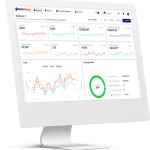Selling on Amazon is a competitive process. Only those who can adapt consistently to the current market changes have a better chance at surviving and proliferating. Amazon sellers must optimize the product lifecycle, track sales, and focus on marketing successful products to maximize their revenue opportunities. To sell optimally on Amazon, you need to do your homework. If you jump onto the bandwagon without conducting research or using appropriate data points, in no time, you will have to face thinning margins, and your revenue will start to erode. The research does not end once you identify the right product. It is a continual process that requires keeping the various factors in sight and adopting quality business practices and generating a higher return on investment (ROI).
The use of appropriate data points and analytics allows you to get in early on the product lifecycle, maximize value when demand is increasing, and create room for competition. It will help create a critical opportunity to get the chosen product started on the right foot. The products within your mix should display the required qualities so that you can build the right momentum for your business. Innovating your business processes with a technological solution can help you tweak your selling strategy and achieve your business goals. KwickMetrics is a cutting-edge technology that aims to help Amazon sellers with their Amazon business. It allows the sellers to bring data and insights into their business practices and steer them towards success.
The tool that the Amazon sellers uses, should provide them with access to a wealth of resources to help them optimally execute their Amazon FBA business. It must offer them actionable insights on their product listings, check sales and financial performance, and deliver according to customer requirements. When choosing the right tool, the stakeholders must consider the following pointers.
Business Requirements
When sourcing out the best Amazon seller tools with the right features and capabilities, you need to analyze your business requirements. You must identify what purpose the tool must serve. List down the specific functions it should support, such as to support product research, sales data management, identifying competition, creating Amazon listings, customer analytics, managing PPC ads, track finances, among various other things. You can prepare the catalog of requirements that the tool must support. It will enable the device to support your business processes effectively.
Vendor Support
When selecting the best tool in the market, you need to review the vendor support for the prospective device. It will enable you to quickly onboard the tool and face minimum hassles in managing it across the lifetime. The consistent assistance from the vendor will help ensure that you can get immediate support whenever you face a technical glitch. Thus, the software will not suffer downtime for elongated periods and will not affect your business continuity.
Pricing
Consider the pricing structure of the potential Amazon seller software. The vendor must provide transparent pricing details for the tool so that its cost does not multiply significantly over time. Review how similar tools are priced in the market, and get a better idea of what you are paying for. A device with a lower initial cost may not necessarily be the right choice, and it may provide features of sub-par quality. You can run a Proof of Concept on the tool to demonstrate its feasibility in business processes before integrating it.
Integration
Determine if you require a standalone or integrated solution. If you opt for an integrated software solution, you need to check how it fits your business platform. It will enable us to function optimally in collaboration with other software in the infrastructure and pull data points together to overcome traditional siloes. Amazon sellers require such integration features to ensure that all the essential aspects of their selling business are covered. Cloud-based software is a more dynamic option, as it provides easy integration capabilities. It is generally available in a pay-as-you-go model, making it easier to access resources on demand.
Compliance
The tool must enable you to maintain the regulatory and statutory compliance requirements required by Amazon. Compliance rules are evolving and tend to frustrate sellers daily. The sellers who have long-term visions for growth must navigate effectively through the compliance requirements to stay competitive and maximize productivity.
Scalability
Choosing a scalable service will help ensure lower maintenance costs, high agility, and a better user experience across its lifetime. Ensure that the software supports easy scalability to access required resources quickly and respond to changes immediately.
Data Security
The software will access business, performance, sales, financial, and customer data. Thus, it must integrate robust data security solutions to help ensure that it keeps the data protected from bad actors and cyber-attacks.
To Conclude:
When selecting the best Amazon seller software, you should keep an eye on these pointers to make the right pick. It will help you bring the desired technological innovation to your business processes and maximize sales potential.

Internet is a must when buying the B2C eCommerce platforms like Amazon. Connect with Streamtech fiber internet for you to have a reliable and stable internet connection. Vist their website at www.streamtech.com.ph